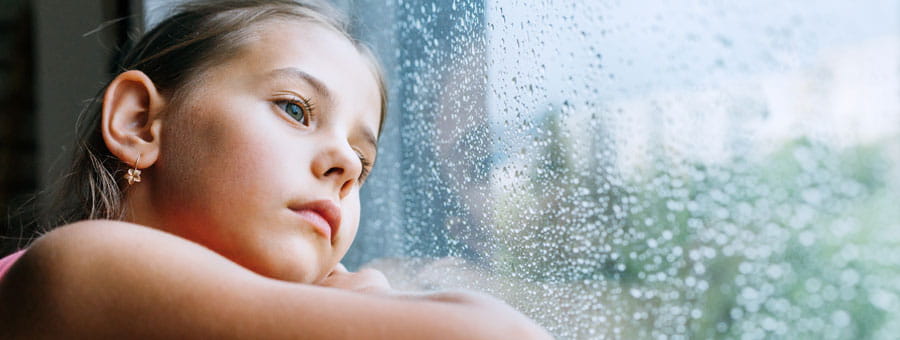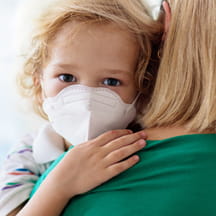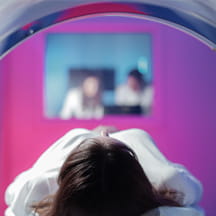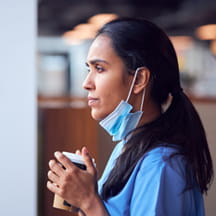1. Adult stress affects children
Schooling in models different than the norm, isolated and socially distant, children and adolescents have undoubtedly experienced increased mental, emotional and behavioral health issues resulting from the pandemic. But they also could be shouldering emotional distress from the adults in their lives.
A Kaiser Family Foundation study published earlier this year reports 4 in 10 adults nationwide have reported symptoms of anxiety or depressive disorder—a four-fold increase from pre-pandemic levels. And adults in households with children under 18 years old were more likely to report these symptoms.
“You’ve got parents who are stressed—they may have lost jobs, and there are financial stressors out there,” says Gary Blau, Ph.D., executive director of The Hackett Center for Mental Health in Houston, Texas. “There’s a whole host of environmental factors that have given rise to significant increases in concerns related to children’s mental health.”
This all came at a time when there was already a shortage of behavioral health care providers in the U.S., particularly for children. In response, children’s hospitals rapidly ramped up telehealth capabilities, but that doesn’t account for the children and adolescents with unidentified behavioral health concerns.
Stress in adults brought on by the pandemic could also affect children who aren’t even born yet. Medical research has long demonstrated a link between maternal stress and adverse pregnancy outcomes. A 2020 Journal of Pediatrics report cites long-term follow-up studies of individuals conceived and in utero during pandemics, natural disasters and famines, including the 1918-1919 flu pandemic, the North American ice storm of 1998 and the Chilean earthquake of 2010.
Those studies show the potential for lifelong negative consequences of such shocks, including lower educational attainment, increased likelihood of obesity, noncommunicable diseases and mental health problems.
2. Developmental issues across all age groups
As for the current population of children living through these times, little data exists on how the pandemic may specifically influence their development. “It’s no surprise that the pandemic creates all these different potential risks to child development,” Blau says. “We’re going to have to attend to those in the months and the years to come.”
The issue cuts across all age groups. For younger children, learning key social skills can be delayed without access to day cares or playdates and face coverings on the people they are able to meet. For older children, isolation means fewer opportunities to build crucial relationships.
“Adolescence specifically is a critical developmental state because young people are trying to transition into adulthood,” says Tamera Coyne-Beasley, M.D., M.P.H., the Derrol Dawkins, M.D., Endowed Chair in Adolescent Medicine, Children’s of Alabama in Birmingham. “They’re now trying to figure out who they are, and a really important part of that is trying to develop stable, healthy and meaningful relationships with their peers—that’s what is hard.”
Blau says the key to mitigating these risk factors moving forward is to engage everyone in a child’s world to identify and work toward solving potential issues.
“It’s not only about pediatricians, doctors and psychologists—it’s about the family members, teachers, neighbors, police officers and coaches,” he says. “Everyone who’s touching a child’s life should be aware of the signs and symptoms when a child is having problems, know what they are and how to help or make referrals.”
This became more challenging when pandemic-driven online schooling models removed an integral safety net of daily interactions for children with teachers and school staff. It also deprived millions of children access to school-based clinics, often their only means to health care.
“It’s something that’s been taken away from them and has been very difficult,” says Coyne-Beasley. “School is a place where kids have access to health professionals—sometimes including counselors and mental health professionals—right where they are.”
3. Widening education gap and inequities
Educational inequality—unequal access to education and the unequal outcomes for students that result—in the U.S. is due to several mostly socioeconomic factors and was present long before COVID-19. And while pandemic-related changes in schooling affected all children, disadvantaged student populations were more heavily affected.
“I see a widening disparity of educational attainment given the challenges larger districts in particular have faced throughout the pandemic—especially in our large cities—and just how hard it’s been to get schools to reopen in those cities,” says David Rubin, M.D., MSCE, director, PolicyLab, and director of population health innovation at Children’s Hospital of Philadelphia. “How quickly we bounce back from that is going to be important.”
Early attempts to bounce back involved widespread remote learning programs, but those also exposed inherent inequities.
“Virtual school participation requires some economic resources, like having a computer and internet access,” Coyne-Beasley says. “And I think children, particularly younger kids, do best with virtual school when they have someone who can assist them; if they have a parent who has to work and can’t be home, it’s difficult for them to get the help they might need.”
Coyne-Beasley adds that remote learning modalities can be especially difficult for children with learning disabilities or those who simply fare better in a social learning format.
“It’s a year of lost education, and the data would suggest that’s hugely impactful,” Rubin says. “It’s going to be a tremendous challenge because the disparity in terms of that education gap has widened as we’ve gone through this pandemic.”
4. Adverse childhood experiences
Adverse childhood experiences (ACEs) have been linked to chronic health problems, mental illness and substance misuse in adulthood.
According to the Centers for Disease Control and Prevention (CDC), more than 60% of adults have reported they had experienced at least one type of ACE, such as divorce, death in the family, violence, or any aspect of the environment that undermines a child’s sense of safety, stability and bonding. Nearly 1 in 6 adults reports experiencing four or more types of ACEs.
Pediatric medicine has placed an increased emphasis in recent years on identifying and mitigating ACEs, but the response to the pandemic may be amplifying some of them. Social isolation, job loss, school closures and other stressors the pandemic caused could expose children to ACEs, especially those associated with job, food and housing insecurity.
The pandemic’s social and economic effect on families—including those in low-income and populations of color, which are disproportionately affected by COVID-19—could linger for years.
“Anyone who experiences adverse community environments like high unemployment, limited economic mobility, food deficits and poor housing conditions are at greater risk of getting COVID-19,” Coyne-Beasley says. “And having high unemployment generally means you aren’t going to have easily accessible health insurance, or you aren’t going to be able to leave your job when you or your child are sick.”
As the U.S. death toll from COVID-19 continues to climb, many children and adolescents must deal with the significant adverse childhood experience of losing a loved one. According to a model published in JAMA Pediatrics, nearly 40,000 children have lost a parent to the coronavirus.
“Bereavement predicts negative outcomes to a larger extent than even trauma does,” Blau says. “We have a large group of young people who have lost parents and family members; we must address the issue of bereavement in children.”
5. Rare related illnesses
Health officials continue to wrestle with why some develop multisystem inflammatory syndrome in children (MIS-C), a rare but serious condition associated with COVID-19, and others do not. The case numbers of children afflicted with MIS-C so far are relatively small—as of April 2021, the CDC reports 3,185 cases nationwide and 36 deaths.
“While the number of MIS-C cases is small relative to the number of COVID-19 infections, it’s much more than we would like it to be,” Coyne-Beasley says. “And if it hits your household, it has a huge impact.” Throughout the pandemic, the risk of a serious COVID-19 infection has been much higher for adults than children. But Rubin says the presence of MIS-C serves as a reminder to remain vigilant.
“It just makes us mindful that we still have a responsibility to ensure the safety of kids,” Rubin says. “We still think the risk of moderate to severe disease is extremely low in kids, but they can get infected with this virus, and they can transmit it too.”
6. Fewer pediatric wellness visits
It may seem sensible enough. In the throes of a once-in-a-lifetime pandemic and stay-at-home orders, perhaps the last place a parent wants to take their healthy child is a doctor’s office. But the results of that behavior could have long-lasting consequences.
A 2020 Centers for Medicare & Medicaid Services (CMS) report shows troubling downward trends in health care utilization during the pandemic.
From January to May 2020, the number of Medicaid and Children’s Health Insurance Program (CHIP)-enrolled children under age 2 receiving vaccinations declined by more than 30%. From March to May 2020, there were sharp declines in key health services for Medicaid and CHIP beneficiaries ages 18 and under:
- More than a 40% decrease in health screenings.
- 44% fewer outpatient mental health services.
- Nearly 75% reduction in dental services.
And, importantly, while child health services utilization has begun to increase as states relax stay-at-home guidelines, usage of these essential child health services has not yet returned to pre-pandemic levels.
“We’ve lost time on immunizations, and that creates some risk in the short term in regard to vaccination coverage rates for kids,” Rubin says. “We can play catch up there and hopefully these delays have not created undue risk over the long term, but we have an urgent need to get kids back to their well visits.”
Coyne-Beasley says she’s seen a drop in patient visits for adolescents during the pandemic—and it’s not just routine checkups that have been compromised.
“We’re not even getting people in to be seen for their chronic conditions,” Coyne-Beasley says. “If someone has asthma or any other chronic condition, they’re not coming into the office in the same way they would have previously.
7. Lingering physical challenges and unknown long-term outcomes
To date, more than 3.4 million kids in the U.S. have tested positive for COVID-19, according to data from the American Academy of Pediatrics and the Children’s Hospital Association, compared to over 30 million adults.
While hospitalization and death from COVID-19 is uncommon in children, providers are only beginning to understand the effects on the long-term physical health of infected children.
“As we saw the pandemic unfolding and information was coming out about pediatric cases, we thought it would make sense for us to start a multi-disciplinary clinic to get a look at children post-COVID and provide them with multi-disciplinary care,” says Melissa Trovato, M.D., director of rehabilitation, Kennedy Krieger Institute in Baltimore, Maryland.
“Our goal is to help them get back to being kids, and that’s really what pediatric rehabilitation is all about—getting kids to live as functional and normal lives as possible.”
At Kennedy Krieger, a COVID-19 rehabilitation clinic addresses patient needs across disciplines, including occupational and physical therapy, speech-language pathology, behavioral health and assistive technology. An evaluation determines the severity of the patient’s condition and whether rehabilitation services on an outpatient, day program or inpatient basis are appropriate.
Trovato says it’s challenging to develop a rehabilitation protocol for a new illness that can cause a wide range of symptoms, so it’s important for her team to lean on its knowledge.
“The great thing about being in pediatric rehabilitation is that we can draw from our experience,” Trovato says. “There might not be a one-treatment-fits-all solution, but as we assess children, it will drive what the care will look like in standardizing protocols.”
Helping kids move forward
It may be several years before the full effects of the COVID-19 pandemic on kids are known, and their recovery could take even longer—if they recover at all.
While the challenges are substantial, it has highlighted opportunities where children’s hospitals and health systems and their community partners can help ensure kids’ needs are being met. For example, the crisis has underscored the importance of behavioral health screenings as part of the physical component of care.
It has also highlighted the integral role schools have in the lives of children. Though schools’ primary roles are to educate, they’ve evolved to encompass a broader responsibility for the mental and physical well-being of children—and that presents an opportunity for children’s hospitals.
“As we move forward, it places skin in the game for hospitals to be more intimately involved in public health, in school-based health response in their regions, and helping develop the programs these schools need to ensure the health of children,” Rubin says.
“It’s more of a decentralized approach, but it captures kids and families where they are; there’s an important role as regional anchors that children’s hospitals need to play, and one this pandemic has really elevated in the months and years to come.”
The disproportionate effects of COVID-19 across economic, racial and ethnic lines have highlighted inequalities in America—and elevated an area of focus for children’s hospitals.
“One of the things hospitals can do, and you’re starting to see this more across the country, is to acknowledge that racism and inequities exist, and the social determinants of health and adverse childhood experiences really do matter,” Coyne-Beasley says. “Children’s hospitals also need to take intentional action to address or eliminate these disparities and experiences.”
Blau says the opportunity is there to build on community relationships. “The relationship between health providers, public health and schools is stronger than it’s been in a long time,” he says. “If we invest in infrastructure now, we can solidify relationships that are primed to shape our response to kids’ needs in the years ahead.”



